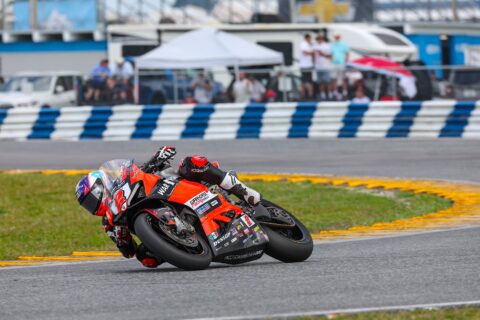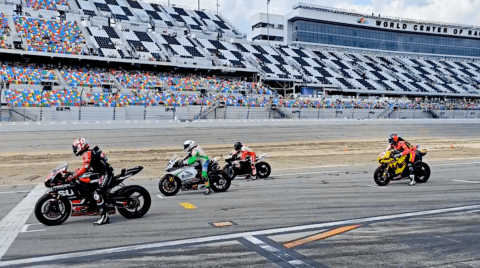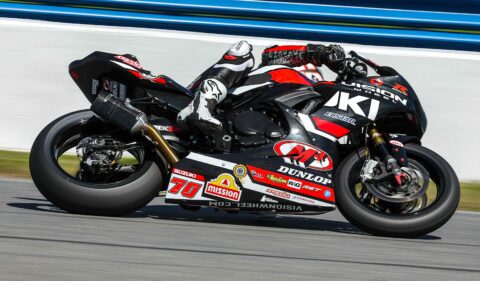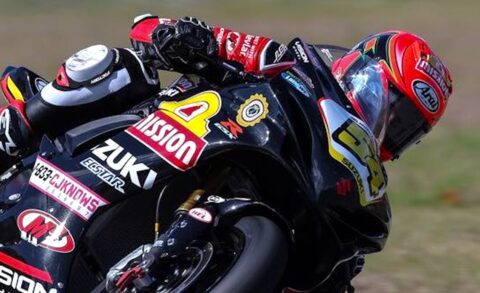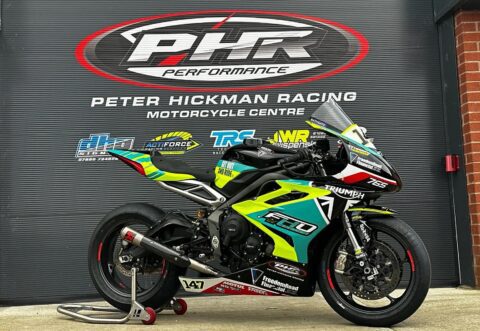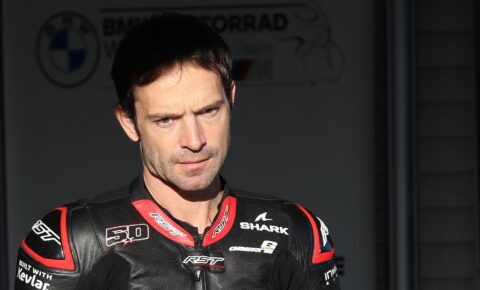Looking into the future is generally a bit of a mug’s game but it’s also a lot of fun to look at where we might end up in a few years’ time. And when it comes to motorsport in general, that looks more and more like a move to electric power.
Governments are banning new petrol and diesel-powered cars and light trucks, by 2030 in the UK and the USA, 2025 in places like Norway. It seems unlikely that firms will keep on racing internal combustion engines for long when they don’t sell them any more – it’d be like Mercedes running a showjumping team, or Ford getting into world championship darts. Anyone for a new Ford Oche?
You’d have to be mad to think that motorcycles are going to escape this change either. No matter how much kicking, screaming and mewling for a return to 500GP two-strokes we come up with, motorbike racing will be changing over the next 10-15 years, loathe it or despise it.
But what is that likely to mean? We’ve spoken to a few people who have their own informed viewpoints, from MotoE boss Nicholas Goubert, to Oliver Holt, the chair of the Electric Road Racing Association which is running grassroots events here in the UK. We’ve also spoken to Ruariadh McDonald-Walker, technical director at McLaren Applied, the firm which produces the electric motor, transmission and electronics used in Formula E electric car racing.
The first thing you’re probably thinking about when it comes to electric bike racing is the MotoE championship. It’s in its third season as a MotoGP support series, using production-based race bikes based on the Energica Ego electric superbike, over a limited calendar. It’s very much a toe in the water for Dorna, but is a great example of ‘where we are’ with the current state of electric bike racing.
I actually had a ride on one of the MotoE bikes at Valencia at the end of 2019, so got to sample the experience first-hand as it were. The differences are fairly stark compared with ‘normal’ racing: the bikes are very heavy, around 260kg, and with 160bhp peak power, the power to weight ratio is well below road-legal superbikes, even from a few years back. The races are also short – around 15 minutes long, with not even enough spare juice for a victory lap. The series has done well considering the massive change in logistics, organisation and technology, especially after a huge fire in 2019 destroyed all the bikes and charging infrastructure just two months before it was due to kick off.
Nicolas Goubert told us how MotoE has got to where it is, and also fielded some of our queries about the future. First off, does he think MotoE has achieved what it set out to do?
“The main objective was to show people that it could be as entertaining to watch a MotoE race as a petrol engined race, that it would be a similar show. And I think we achieved this. If you watch a MotoE race on TV, with the volume turned off, I bet 95 per cent of the people would not even realise that they are electric bikes. We have the same type of fights, overtaking, all the uncertainty we have in normal bike racing, and this was one thing that we wanted to have.
And also we were really happy to see quite quickly that riders in MotoGP were really interested in watching the races too. We had comments from Fabio [Quartararo], Marc [Marquez], from Jack Miller, comments about the races. They were quite excited watching it. And that was proof for us that we had achieved that first objective.”
MotoGP riders are smart cookies of course, and the young guys know that they could easily end up on electric race bikes well before the end of their career. Indeed, MotoE has attracted a few former) MotoGP contenders, including Sete Gibernau and Bradley Smith, to assist in development while competing. So it’s perhaps no surprise that they’re keeping an eye on progress. But what changes does Goubert think are needed over the next season or so? Do the bikes need more range and power, or less weight?
“The main issue for us is the weight. To be honest the autonomy [range] of the bikes is not such an issue, because we now have 15 minute races. And more and more, young people don’t sit in front of the TV for hours, they go from one program to another. So you have to offer them a thrilling show, and 15 mins, okay maybe it’s a little bit short. But of course, 15 minutes is not so unusual in national race series.”
Short races to suit short attention spans then? Mind-blowing stuff. Will they have the same excitement levels, intrigue and strategy? Goubert laughs. “The good thing is that in a 15 minute race, you are sure that the show is going to be created from the first lap to the last lap – because you can only have one strategy! To win! When I started in 2018 I was quite worried about the range. And Carmelo Ezpeleta, he kept telling me, ‘don’t worry, I don’t care! In 500GP we didn’t have flag to flag races, the guys stopped when it started raining and then we started the second race with the remaining laps’. He kept telling me the best races were those second races – the short ones. So range is not so important, but yes the weight for sure, that is one thing we want to see coming down.”
Less weight then – which is a fair point on a 260kg bike. How does Goubert see that happening? “Right now, the bike we are using is basically a modified street bike. We picked the Energica Ego because it was the best electric sportsbike on the market, so we knew reliability wasn’t going to be an issue – and we also knew that they had the capability to make the 20 bikes we needed. It’s ‘raceable’ but it is still a street bike. Now, if someone built a specific bike only for racing, it could take the weight down, even with today’s battery technology. After that, of course, the next step will be new battery technology on the market. Not for more range, but for the decrease in the weight.”
So – two avenues for improvement that don’t seem too far away in terms of the required tech: a move to a ‘proper’ prototype racebike, with a lighter chassis and optimised powertrain, and none of the compromises inherent in a production-based roadbike design. And advances in battery technology that are being driven by the huge demand for battery-powered cars. But what about the big step that electric bike racing seems to need – moving from a single-make grid, with identical bikes wearing different sponsors’ stickers, to teams racing their own bikes? Or the halfway-house of a ‘Moto2’ model, with a control powertrain and teams designing everything else?
“It’s really difficult to see where we’ll be going and when,” said Goubert. “But you’re right, what you suggest is what they’ve been doing in Formula E. At the beginning everything was the same, and they put different colours on the cars like they do with our bikes. But then they said you can change the engine, you can use a gearbox, but you still have the same chassis and battery pack. You cannot open that to everyone because it would cost a lot of money and you would have great differences between the team depending on the money.”
This all seems very reasonable – but we wanted to hear some more other suggestions on how electric bike racing could develop. And Ruaraidh Macdonald-Walker was just the man. He’s the technical director at McLaren Applied – part of the McLaren group – and specialises in mechanical and electronic engineering solutions like the hybrid KERS and MGU-H energy recovery systems used in F1. He also owns an old Suzuki RG500 and a GSX-R1100 – so he knows what makes motorbikes fun. What does he see coming for electric bike racing?
“MotoE is exciting to see,” he says. “And electrification is going to be everywhere, from road cars to electric hover-taxis in cities. All this will definitely be a thing in the early 2030s.”
He’s intrigued by some surprising possibilities though. Firstly in terms of the possibilities for traction control on electric drivetrains compared with internal combustion engines. “I remember the first ABS system on a BMW bike, it was clunky and awful. And now you have incredible rider aids, which just means you can dial up the aggressiveness with track modes, wheelie control, traction control, switchable ABS. But all this still has to be channelled through an engine, the suck-squeeze-bang-blow thing. But with electronics you have even more control, you can command more current into an electric motor in 5-10 milliseconds which is an order of magnitude faster than the rider wants. You can do a lot of stuff before the rider is even aware of it – you can have five or six control loops in the 300 milliseconds that a person needs to even think.”
That’s not the only possibility he sees. “Why do we not have front wheel drive or two-wheel drive bikes? It’s difficult with a petrol engine, but easy with an electric motor. You have some cables, but that’s it.”
Two-wheel-drive race bikes sounds like lockdown fever madness at first. But Macdonald-Walker comes up with the reason for that thinking – regenerative braking. Almost all electric cars have the ability to ‘reverse’ their drive motors, turning them into electric generators. They then act as a brake, slowing the car down while converting the kinetic energy into electric charge and feeding it back into the battery. It’s ‘free’ energy normally wasted as heat on petrol-engined vehicles, and capturing it adds efficiency to the electric drive.
Now, you could add this to a conventional rear-wheel drive electric bike, but the amount of brake force available on the back wheel is of course limited; as weight transfers onto the front wheel, the back wheel locks up. Fit a motor/generator on the front wheel, though, and you can apply the regenerative braking as hard as you like till the back end comes off the ground. Put that back into the battery and you have more range – or as Nicolas Goubert wants, a smaller, lighter battery pack to last for your 15-30 minute race.
“There are limits here – one fundamental issue is that you (obviously) can’t charge a full battery pack. You’d be snookered trying to use regenerative braking into turn one at Mugello off the start line. It’s also difficult to quickly absorb large amounts of current into a battery, meaning things like supercapacitors might be needed.
So we couldn’t entirely replace the Brembo carbon discs with electric braking, but you could maybe see a single brake disc instead of two, with some cunning electronics to balance the mix of braking force. The top riders might also be able to marshal braking and regeneration all through the race: getting more juice back into the battery could mean you can ‘turn up’ your motor on the last lap to use every last joule of energy remaining in the run to the finish line.”
Putting an electric motor inside the front wheel would no doubt add some unsprung mass, but careful design (and posh, expensive components) could cancel much of this out. Using the outer structure of the motor as an integral part of the wheel hub would help – and is a technique already in use. “Look at Formula Student racing,” said McDonald-Walker. “The shit-hot cars are electric, four-wheel-drive, and the really good ones have a high speed motor with a planetary gearbox and a Buell-type disc brake. The ‘wheel’ is just a carbon-fibre rim tabbed onto the outside of the assembly, the rest of the structure is the motor.”
As I’m writing this down, I’m already trying to get my mind around the possibilities of someone like Marc Marquez, with instantly-controllable drive vectored to both wheels. Imagine the crash-saves possible there, thin wisps of smoke coming off both ends, spinning up at the perfect yaw-angle around Mugello or Phillip Island…
I ask McDonald-Walker about some other areas of techno-advance, like hydrogen powered fuel cells and hybrid drives. ‘Fuel cells aren’t going to work on a bike. They’re big, heavy, complicated and inefficient, and you need big cylindrical tanks to carry the gas. You also need a battery as well, because fuel cells can’t do regeneration – they can’t turn electricity into hydrogen and oxygen again. They also can’t do transient demand; you can’t change the rate [of power output] easily.”
“I’m not sure a hybrid is much use on a bike either. Space and weight are at a premium and it doesn’t suit the type of drive cycles bikes experience. The best way would be to have a ‘through the road hybrid’ with an electric front wheel drive and a small battery just for acceleration boost and brake absorption.”
So – there’s a bit of a deep dive into the technological possibilities. And to be honest, I’m quite excited about what could be coming: two-wheel-drive prototype racebikes, with riders vectoring drive between front and rear ends, microsecond-quick control of the motors, regenerative braking setups, dicing over the course of shorter, sharper 15 or 30 minute races. Or with the removable battery technology that Honda, Yamaha and KTM are pioneering, perhaps we’ll have power pit-stops, with riders pulling in to have a fresh battery pack swapped in for the second half of a 40-minute race. Hell, we could see an electric Suzuka 8-Hour, with 20-odd battery swap pit-stops factored into the fun and games of endurance racing.
But none of this will come without the other part of the racing deal we mentioned earlier – an industry that wants to take part for the PR and marketing possibilities. Remember, no matter how much you love the passion and mythology of motorbike racing, in the end, it’s all just about selling stuff. And without mainstream electric road bikes in the market, there’s little incentive for the big firms to go electric racing.
Nicolas Goubert, of course, knows what is needed. “Formula E went pretty well because they could attract car makers, that is the way to do it. All the big car brands have electric vehicles and have plans to launch many more, so of course they are interested in taking part in electric car racing. That’s not the case in the bike industry – yet. But the day that Yamaha, Honda, Suzuki, Triumph have a nice electric bike offer, then I’m sure people will come round. It will take time.”
It’s ERRA, innit…
While MotoE and McLaren are working at the highest levels of racing, the Electric Road Racing Association is looking to do it on the front line. Set up in late 2019 after the cancellation of the Isle of Man TT Zero, it aims to provide a home for the teams which were looking to compete in electric racing – including several university-backed teams.
Oliver Holt is the chair of ERRA, and he told us how they see the future. “The short-term goal is to go racing with teams who already have electric bikes. Then, looking forward, the aim is to grow electric racing, in a sustainable way. Our new rules are designed to make it very straightforward to race both custom and production electric bikes such as Zeros or Energicas.
“Over time we plan to have a more sophisticated class structure (similar to separating combustion bikes by displacement) and a very straightforward route for anyone to turn up on a weekend and race electric bikes.”
Could the ERRA help support a BSB support race series, say? “We’ve not had any discussions with BSB although we would certainly entertain them. It would be possible to run a one-make feeder/support series based on something like a Zero SR, given enough will and financial backing. A grid of prototype bikes could also be possible but that would cost more and be less in the spirit of racing something vaguely similar to what you can buy in your local dealership.”
Holt sees the same problem that Nicolas Goubert points to here – the lack of mainstream electric road bikes in the market at the moment. “Perhaps in a few years’ time a “BeSB” championship with factory-supported electric bikes will be viable. But I don’t think we’re quite there yet, mostly in terms of manufacturer offerings more than anything else.”
Holt’s certain that proper electric bike racing is coming though. “At some point ‘electric bike racing’ will just become ‘bike racing’. I can’t tell you when that will be yet but it won’t be much after manufacturers stop producing combustion engines for most markets. Probably in the 2030s would be my guess.”
Finally, just like Ruariadh McDonald-Walker and Nicolas Goubert, Holt is very excited about the new possibilities opened up by electric power, rather than just the ‘green’ environmental aspects. “There’s going to be far more innovation racing in the next ten years than there has been in the last 40 years, just because there are so many new opportunities that electric power can offer – even before considering new technology. It’s like being back in the early days of motorcycling with everyone trying new things and figuring out what works as they go. The future is electric and I’m sure it will be exciting…”


